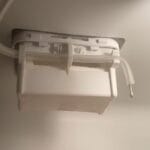Steep stairs with little headroom can be a real headache, can’t they? If you’ve ever ducked and dodged your way up a staircase, you know how frustrating and potentially dangerous it can be.
You might even feel like you’re navigating an obstacle course in your own home. But don’t worry—you’re not alone, and there are solutions to make your stairs safer and more comfortable. Imagine walking up and down your stairs without the fear of bumping your head or losing your balance.
We’re going to show you how to fix those steep stairs with limited headroom, making your home a safer and more pleasant place. You’ll discover practical tips and tricks that you can apply right away, transforming your staircase into a space that’s both functional and inviting. Stay with us, and let’s get your stairs sorted out.

Credit: es.pinterest.com
Assessing The Problem
Evaluating stair problems involves identifying steep inclines and low headroom. Pinpointing these issues is crucial for safety and comfort. Understanding the specific challenges helps in choosing the best solutions for improving accessibility.
Assessing the problem of steep stairs with little headroom can seem daunting, but it’s the first step to ensuring safety and comfort in your home. You might have noticed that navigating these stairs feels like a balancing act, leaving you ducking and dodging with every step. Recognizing the specific issues at play is crucial for effective solutions.
Identifying Steepness And Headroom Issues
Begin by measuring the angle and rise of your stairs. A steep staircase typically has a rise greater than 7.5 inches and a run less than 10 inches. Next, check the headroom, which is the vertical space between the steps and the ceiling. Ideally, this should be at least 80 inches to prevent any risk of hitting your head. If you’ve ever felt like you have to crouch while climbing, it’s time to take action.
Safety Concerns And Implications
Steep stairs with inadequate headroom aren’t just inconvenient—they’re dangerous. They increase the risk of falls, especially for children and the elderly. Consider how these stairs affect your daily routine. Are you constantly worried about tripping or bumping your head? It’s a valid concern that requires attention. Addressing these safety issues can also enhance your home’s value. Buyers look for safe, accessible homes, and fixing steep stairs could make all the difference. Do your stairs make you think twice before using them? It’s time to assess and address these critical issues for a safer and more comfortable living space.
Design Modifications
Steep stairs with little headroom can be a daunting challenge in any home. Whether you’re renovating an old house or adjusting your current space, design modifications can make a significant difference. Let’s explore some practical ways to improve your stairs for safety and comfort.
Adjusting Stair Angle
Changing the angle of your stairs can drastically improve headroom and ease of use. By making the stairs less steep, you create more space above each step. This adjustment might involve extending the staircase or reconfiguring adjacent walls.
Consider how often you or family members use the stairs. Is the current angle causing discomfort or even danger? A more gradual slope can make daily use much easier.
When I renovated my own home, adjusting the stair angle was a top priority. It not only added comfort but also enhanced the overall flow of the space.
Reducing Riser Height
Lowering the riser height is another effective strategy. Shorter risers can make climbing stairs less strenuous and reduce the chances of tripping.
Measure your current risers and compare them to recommended standards. Ideally, risers should be around 7 inches high. If yours are taller, you may need to add more steps to maintain a safe angle.
Think about the long-term benefits. Reducing riser height isn’t just about immediate comfort—it’s an investment in your home’s accessibility as you age.
What changes could you make today that might save you from future headaches or injuries? Reflecting on these questions can guide you in making the best design choices for your stairs.
Structural Solutions
Fixing steep stairs with little headroom can seem daunting, but structural solutions offer practical ways to address this challenge. Whether your stairs are in a vintage home or a modern setup, understanding how to make structural modifications can improve safety and comfort. Let’s dive into the specifics that can transform your staircase into a more user-friendly space.
Extending Staircase Length
Imagine giving your stairs more room to breathe. Extending the staircase length can significantly reduce steepness, providing a safer ascent and descent. You might wonder, how does this work?
- By adding extra steps, you distribute the height more evenly.
- This adjustment decreases the angle of the stairs, making them more manageable.
Consider the impact on your daily life. With less steep stairs, you reduce the risk of slips and falls. This change doesn’t just benefit you; it enhances accessibility for everyone in your home.
Reinforcing Staircase Support
Reinforcement is key to stability. Stronger support means your stairs can safely handle the weight and traffic they endure daily. But how do you achieve this?
- One option is to strengthen the existing framework with additional materials.
- Another is to add brackets or braces that bolster the structure.
Think about the peace of mind that comes with reinforced stairs. When your stairs feel solid underfoot, it transforms your home into a safer haven. Consider how this upgrade could protect your family, especially during those busy mornings when everyone is rushing down.
Have you ever thought about the long-term benefits of these changes? A structurally sound staircase not only enhances safety but can also add value to your property. What steps will you take to fix your steep stairs with little headroom?

Credit: www.youtube.com
Space Optimization
Fixing steep stairs with little headroom can seem daunting, but space optimization can make a world of difference. By maximizing every inch of your staircase area, you can create a safer and more functional space. Let’s explore how to make the most of your stairway’s potential.
Utilizing Vertical Space
When dealing with limited space, think vertically. Adding shelves above the stairs can provide extra storage without sacrificing headroom. Consider installing hooks for hanging items like coats or bags, which keeps the area tidy and frees up floor space.
Have you ever noticed how much unused space is lurking above your head? A wall-mounted bookshelf can transform an empty wall into a library, perfect for those cherished books you can’t part with. Just ensure it’s securely fastened to avoid any accidents.
Innovative Storage Solutions
Steep stairs often come with tight corners, making traditional storage challenging. Consider custom-built drawers or pull-out cabinets that fit snugly under each stair tread. These not only provide storage but also enhance the aesthetic appeal of the staircase.
Imagine opening a step to reveal a hidden drawer filled with shoes or seasonal items. It’s a clever use of space that doesn’t interfere with the stairs’ function. Have you ever thought about how much more organized your home could be with just a little creativity?
Think about your lifestyle and what you frequently need access to. Using stair risers for concealed storage can be a game-changer. Picture having a dedicated spot for your keys or mail right at your feet, making it easy to grab what you need on the go.
How do you optimize space in your home? Share your thoughts and let’s help each other create more functional living environments!
Material Choices
Choosing the right materials can help fix steep stairs with limited headroom. Opt for thinner treads and low-profile risers to create more space. Consider using lightweight wood or metal for a sleek design that maximizes headroom efficiently.
Choosing the right materials for fixing steep stairs with little headroom can make a significant difference in the functionality and aesthetics of your space. Your material choice can impact not only how the stairs look but also how they feel and how long they last. Balancing durability, weight, and visual appeal is key to achieving a successful renovation.
Lightweight And Durable Options
When you’re working with limited headroom, lightweight materials can make installation easier and reduce stress on the staircase structure. Consider aluminum or composite materials. They’re known for their strength and are much lighter than traditional wood or steel. Think about the maintenance aspect too. For instance, composite materials often require less upkeep compared to wood, which might demand regular staining or sealing. This can save you time and effort in the long run. Have you ever tried lifting a heavy wooden plank while craned under a low ceiling? It’s not pleasant. Lightweight options can ease installation, particularly in tight spaces.
Impact On Aesthetic Appeal
Material choice can dramatically alter the look of your staircase. Wood can offer a warm, classic look, while metal or glass can provide a modern touch. What vibe do you want your space to reflect? Mixing materials can also be a smart move. Imagine a staircase with sleek metal railings paired with wooden treads. This combination can offer both durability and a striking aesthetic. Your choice of materials can also affect the perception of space. Lighter colors and reflective surfaces like glass can make a cramped area feel more open and airy. Consider how each option will blend with the existing decor and light in your home. Think beyond just function. Your stairs can be a focal point, adding character and value to your property. So, when choosing materials, keep both practicality and style in mind.
Professional Consultation
Steep stairs with little headroom can be a safety risk. Professional advice can make all the difference. Experts bring insights that ensure your stairs are both safe and stylish. Consulting a professional can prevent costly mistakes.
Hiring An Architect Or Contractor
An architect can offer design solutions. They ensure your stairs fit the space. Architects also understand building codes. This knowledge helps in creating safe stair designs. Contractors, on the other hand, focus on execution. They turn designs into reality. A contractor manages the practical aspects. This includes materials and labor. Both professionals bring unique skills. Consider your needs when choosing.
Cost Considerations
Cost depends on the complexity of the project. Simple fixes may cost less. Major redesigns require more investment. Architects charge for their design services. Contractors provide estimates for materials and labor. It’s wise to get multiple quotes. This helps in comparing costs. Budgeting for unexpected expenses is also smart. This ensures smooth project completion.
Diy Techniques
Fixing steep stairs with little headroom can be a challenging task. With the right DIY techniques, you can improve safety and comfort. These solutions are budget-friendly and easy to implement. Whether you are a beginner or an experienced DIY enthusiast, these tips will help.
Simple Adjustments
Start by checking the current stair measurements. Measure the rise and run of each step. Ensure they are consistent. If not, consider adding extra material to even them out. This can help in making the stairs feel less steep. Another adjustment is to improve the lighting. Add brighter lights to illuminate the steps clearly. This reduces the risk of accidents. Adjust the handrails to the right height. Properly placed handrails enhance safety and provide support.
Tools And Materials Required
Gathering the right tools and materials is crucial. A measuring tape is essential for accurate measurements. You will need a saw for cutting any additional materials. Sandpaper helps smooth out rough edges. Wood or plywood can be used to add to the steps. Strong adhesive or nails are necessary for securing materials. A level ensures all steps are even. For lighting, LED strips or bright bulbs are effective. Keep a screwdriver and drill handy for installing lights and handrails. Always wear safety gear like gloves and goggles.

Credit: www.youtube.com
Safety Enhancements
Fixing steep stairs with little headroom requires smart solutions. Install shorter risers to reduce steepness. Add handrails for extra support. Consider lighting to enhance visibility and safety.
When it comes to making steep stairs with little headroom safer, it’s important to focus on practical and effective safety enhancements. These enhancements not only improve the functionality of your stairs but also provide peace of mind. You might be surprised at how simple changes can significantly increase safety.
Installing Handrails
Adding sturdy handrails is a straightforward yet crucial safety measure. Handrails offer support and balance, especially for children and the elderly. Consider installing them on both sides of the staircase to ensure maximum stability. Choose materials that are both durable and comfortable to grip. Wood, metal, or even plastic can be great options. It’s essential to secure the handrails properly, with no loose fittings, to prevent accidents.
Non-slip Surface Treatments
Slippery stairs can be a major hazard, particularly in homes with young children or pets. Applying non-slip treatments can effectively reduce this risk. You can find anti-slip tape, paint, or mats that are easy to apply and come in various colors and textures. Think about the aesthetic appeal as well—your stairs should be safe but also blend seamlessly with your home decor. A friend once shared how they transformed their staircase with stylish non-slip treads that matched their living room theme. Why not add a personal touch to your safety measures? Have you ever considered how these simple adjustments could prevent a potential fall? Making your stairs safer doesn’t have to be a daunting task. By focusing on these enhancements, you ensure a safer environment for everyone in your home.
Frequently Asked Questions
How Can I Make Steep Stairs Safer?
Install handrails on both sides. Add non-slip treads to each step. Improve lighting for better visibility.
What Are Some Headroom Solutions For Steep Stairs?
Consider altering the ceiling shape. Use compact stair designs. Ensure compliance with building codes.
Is It Possible To Remodel Steep Stairs?
Yes, it is. You can reconfigure the staircase. Or install a spiral staircase for better headroom.
What Materials Are Best For Narrow Stairs?
Choose durable materials. Wood, metal, or composite are good options. They provide strength and longevity.
How Do I Increase Headroom Without Major Renovations?
Use thinner treads and risers. Opt for open risers. Consider adjusting the slope gently.
Conclusion
Fixing steep stairs with little headroom can be challenging. Safety comes first. Adjust steps or handrails for better security. Consider lighting to enhance visibility. Check local building codes for compliance. Hire professionals if needed. They offer expertise in tricky spaces.
Remember to plan carefully. Measure twice, cut once. Small changes make a big difference. Enjoy safer stairs with improved headroom. Keep your home functional and safe for everyone. Your efforts can prevent accidents. Create a comfortable environment for family and friends.
Simple solutions can improve daily life.




